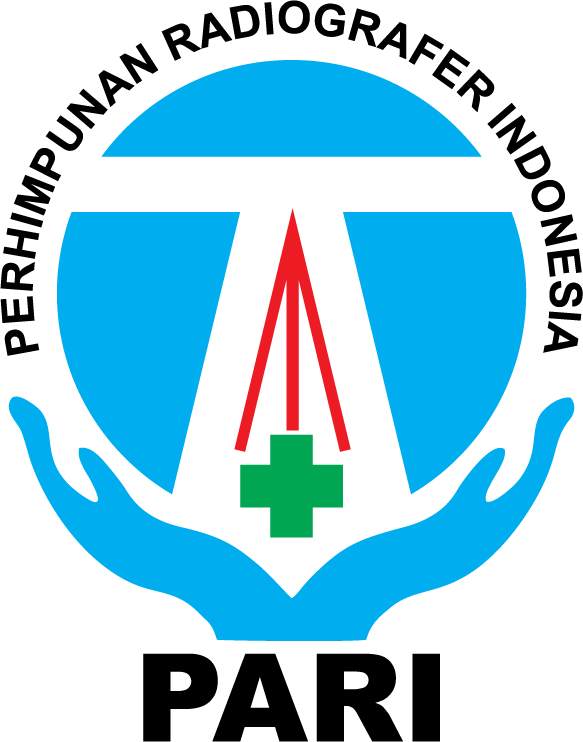Optimasi Informasi Diagnostik Citra Axial MRI Brain antara Sekuen SWI dan T2 FLASH 2D pada Kasus Tumor Otak
Abstract
Background: Pulse gradient echo sequences use varying RF excitation pulses and with NMV flips through various angles (not just 90°). Gradient echo has a sensitive susceptibility effect in detecting the presence of blood products (hemorrhage) and calcifications in brain tumors. The SWI and T2 FLASH 2D sequences are part of the pulse sequence gradient echo, where the SWI sequence is a 3D velocity compensated gradient echo and the T2 FLASH 2D sequence is a 2D multi-slice gradient echo. This study aims to determine the differences in axial image diagnostic information and determine the most optimal axial image diagnostic information in MRI brain examinations between SWI and T2 FLASH 2D sequences in brain tumor cases.
Methods: This type of research is quantitative with an experimental approach. Data was taken in March 2024 at the Radiology Installation of RSUP Dr. Sardjito Yogyakarta. The sample in this study was 10 patients with brain tumor cases. An assessment was carried out by 2 respondents to assess the criteria for brain tumors. The assessment data from respondents was tested using the Cohen's kappa test to assess reliability between respondents and the Wilcoxon test to determine the level of difference in axial image diagnostic information, then the mean rank was used to determine sequences with better diagnostic image information.
Results: The results of the study show that there is a difference in the diagnostic information of axial images on MRI brain examination between SWI and T2 FLASH 2D sequences in tumor cases with a p-value of 0.014. The significant difference is due to the susceptibility effect in both sequences. Based on the Wilcoxon test, the SWI sequence is the most optimal sequence in displaying diagnostic information with a mean rank value of 4.
Conclusions: There is a difference of axial image diagnostic information between SWI and T2 FLASH 2D sequence in Brain MRI with brain tumors cases, and SWI sequence produces the most optimal axial image diagnostic information in MRI brain with brain tumor cases.Keywords
Full Text:
PDFReferences
Baker, G. F., Tortora, G. J., & Nostakos, N. P. A. (2020). Principles of Anatomy and Physiology. The American Journal of Nursing, 3, 477.
Chambers, S. K., Grassi, L., Hyde, M. K., Holland, J., & Dunn, J. (2015). Integrating psychosocial care into neuro-oncology: Challenges and strategies. Frontiers in Oncology, 5(FEB), 1–6. https://doi.org/10.3389/fonc.2015.00041
Chandran, A. S., Bynevelt, M., & Lind, C. R. P. (2016). Magnetic resonance imaging of the subthalamic nucleus for deep brain stimulation. Journal of Neurosurgery, 124(1), 96–105.
Edith J . Applegate, P. (2010). The Sectional Anatomy Learning System. Westline Industrial Drive St. Louis Missouri 63146.
Fraceschi, A. M., Moschos, S. J., & Anders, C. K. (2016). Utility of Susceptibility Weighted Imaging (SWI) in the Detection of Brain Hemorrhagic Metastases from Breast Cancer and Melanoma.
Hageman, G., Hof, J., & Nihom, J. (2022). Susceptibility-Weighted MRI and Microbleeds in Mild Traumatic Brain Injury: Prediction of Posttraumatic Complaints? European Neurology, 85(3), 177–185. https://doi.org/10.1159/000521389
Halefoglu, A. M., & Yousem, D. M. (2018). Susceptibility weighted imaging: Clinical applications and future directions. World Journal of Radiology, 10(4), 30–45.
Kumar, V., K.Abbas, A., & Jon, C. A. (2018). Robbins Basic Pathology, Tenth Edition.
Kwak, H. S., Hwang, S., Chung, G. H., Song, J. S., & Choi, E. J. (2015). Detection of small brain metastases at 3 T: Comparing the diagnostic performances of contrast-enhanced T1-weighted SPACE, MPRAGE, and 2D FLASH imaging. Clinical Imaging, 39(4), 571–575. https://doi.org/10.1016/j.clinimag.2015.02.00
Lampignano, J. P., & Kendrick, L. E. (2018). Bontrager’s Textbook of Radiographic Positioning and Related Anatomy Ninth Edition. St. Louis, Missouri: Elsevier.
Martinez, S., Greenberg, S. M., & Viswanathan, A. (2014). Cerebral microbleeds: Overview and implications in cognitive impairment. Alzheimer’s Research and Therapy, 6(3), 1–7.
McFaline, J. R., & Lee, E. Q. (2018). Brain Tumors. American Journal of Medicine, 131(8), 874–882.https://doi.org/10.1016/j.amjmed.2017.12.039
Observatory, G. C. (2020). Global Cancer Observatory. 33–56. https://doi.org/10.1201/b17751-2
Shams, S., Martola, J., Cavallin, L., Granberg, T., Shams, M., Aspelin, P., Wahlund, L. O., & Kristoffersen-Wiberg, M. (2015). SWI or T2∗: Which MRI sequence to use in the detection of cerebral microbleeds? The Karolinska Imaging Dementia Study. American Journal of Neuroradiology, 36(6), 1089–1095. https://doi.org/10.3174/ajnr.A4248
VanPutte, C., Regan, J., & Russo, A. (2017). Seeley’s Essentials of Anatomy and Physiology. In Journal of Thoracic Disease (Vol. 9, Nomor 8).
Weis, S., Sonnberger, M. Dunzinger, A., Voglmayr, E., Aichholzer, M., Kleiser. R. & Strasser, P. (2019) Imaging Brain Diseases. In Imaging Brain Diseases. https://doi.org/10.1007/978-3-7091-1544-2
Weishaupt, D., Kochli, V. D., & Marincek, B. (2014). Case Study: Flash Mri. 1–9.
Westbrook, C. (2014). Handbook Of MRI Technique Fourth Edition.
Westbrook, C., & Talbot, J. (2019). MRI in Practice Fifth Edition.United Kingdom: Wiley-Blackwel: UK.
DOI: https://doi.org/10.31983/jimed.v10i2.11583
Article Metrics
Refbacks
- Optimasi Informasi Diagnostik Citra Axial MRI Brain antara Sekuen SWI dan T2 FLASH 2D pada Kasus Tumor Otak
- Optimasi Informasi Diagnostik Citra Axial MRI Brain antara Sekuen SWI dan T2 FLASH 2D pada Kasus Tumor Otak
- Optimasi Informasi Diagnostik Citra Axial MRI Brain antara Sekuen SWI dan T2 FLASH 2D pada Kasus Tumor Otak
- Optimasi Informasi Diagnostik Citra Axial MRI Brain antara Sekuen SWI dan T2 FLASH 2D pada Kasus Tumor Otak
JURNAL IMEJING DIAGNOSTIK by http://ejournal.poltekkes-smg.ac.id/ojs/index.php/jimed is licensed under a Creative Commons Attribution-ShareAlike 4.0 International License.

.png)
.png)
.png)
.png)
.png)
.png)
.png)











